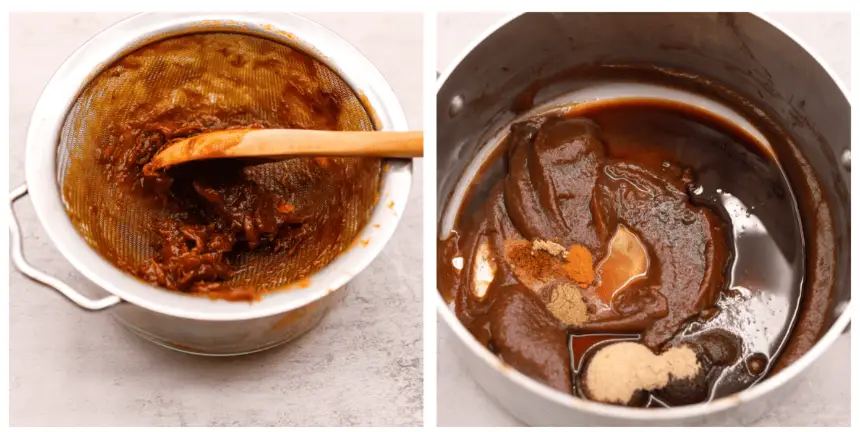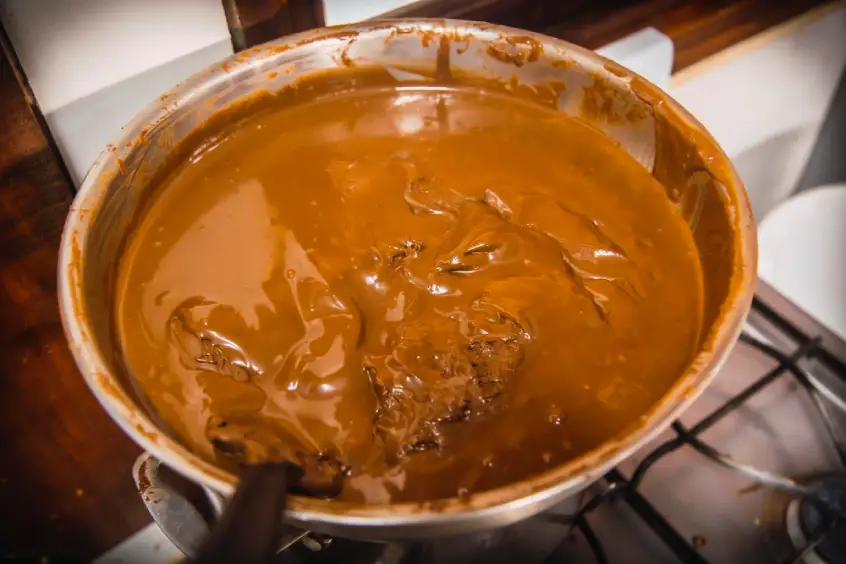Introduction
Tamarind Sauce Recipe, a fruit that’s as complex as it is versatile, has carved a niche for itself in the culinary traditions of many cultures. From the tangy pulp used in Indian chutneys to the sweet-sour base of Thai soups, tamarind’s global footprint is undeniable. Its allure lies not just in its flavor but in its ability to add a layer of complexity to dishes that’s both intriguing and irresistible.
If you’re looking for more with then try Make a chopped cheese new york style, Chopped Cheese Recipe and Beef with Garlic Sauce
What is Tamarind?
At its core, tamarind is a leguminous tree fruit, known scientifically as Tamarindus indica. The fruit’s pulp is encased in a pod-like shell and is the star ingredient in many dishes worldwide. Its taste? A perfect balance of sweet and sour, making it a culinary chameleon.
Nutritional Benefits of Tamarind
Tamarind isn’t just a flavor enhancer; it’s a nutritional powerhouse. Packed with essential vitamins and minerals, it offers numerous health benefits, from improving heart health to aiding digestion. Plus, its high antioxidant content means it’s great for fighting off free radicals, making it a tasty and healthy addition to any diet.
Preparation Basics
Essential Ingredients for Tamarind Sauce
Creating the perfect tamarind sauce starts with gathering the right ingredients. At its simplest, you’ll need tamarind pulp, water, sugar, and a pinch of salt. However, the beauty of tamarind sauce lies in its versatility, allowing for endless variations.
Step-by-Step Tamarind Sauce Recipe
Preparing the Tamarind Pulp
The first step in making tamarind sauce is to prepare the pulp. This involves soaking the tamarind in hot water until it softens, then straining the mixture to remove any seeds or fibers. What you’re left with is a tangy, flavorful base ready to be transformed into sauce.
Combining Ingredients for the Perfect Blend
Once your tamarind pulp is ready, it’s time to combine it with the other ingredients. The key here is balance. You want to achieve a harmonious blend of sweetness, sourness, and saltiness. Simmer the mixture until it thickens, and voilà, you have homemade tamarind sauce.

Variations of Tamarind Sauce Recipe
Tamarind sauce, with its tangy and sweet profile, serves as a versatile base that can be tweaked and twisted in numerous ways. Let’s explore how to add a unique twist to your tamarind sauce by incorporating some unexpected ingredients.
Tamarind Sauce with a Twist: Incorporating Unique Ingredients
To elevate your Tamarind Sauce Recipe to the next level, consider adding ingredients that complement its inherent flavors. For a spicy kick, a dash of chili powder or fresh green chilies can work wonders. If you’re aiming for a more complex flavor profile, incorporating spices like cumin, coriander, or even a pinch of garam masala can add depth and warmth to the sauce. For those with a sweeter palate, mixing in a bit of honey or maple syrup instead of sugar can introduce a nuanced sweetness. And for a refreshing twist, a squeeze of lime juice can enhance the sauce’s tanginess, making it even more irresistible.
Serving Suggestions
Tamarind sauce isn’t just a condiment; it’s a flavor enhancer that can elevate a wide range of dishes.
- Dipping Sauce: Perfect for samosas, spring rolls, or even as a zesty alternative to ketchup.
- Glaze for Meats: Brush it over grilled chicken, pork, or fish for a tangy twist.
- Salad Dressing: Mix it with olive oil and use it to dress your favorite salads.
- Stir-fry Sauce: Add it to stir-fries for an instant flavor boost.
Health Benefits and Dietary Considerations
Health Benefits of Tamarind Sauce
Tamarind sauce isn’t just delicious; it’s also packed with health benefits. Rich in vitamins and minerals, it can aid digestion, help manage diabetes, and even contribute to heart health. Its high antioxidant content also means it’s great for your skin and overall immune system.
Troubleshooting Common Issues
Balancing Flavors
One of the most common issues when making tamarind sauce is getting the balance of flavors just right. If your sauce is too tart, adding a bit more sugar or honey can help mellow it out. Conversely, if it’s too sweet, a little extra tamarind pulp or a splash of lime juice can bring back that desired tanginess.
Tamarind Sauce in Traditional Ceremonies
In many cultures, tamarind sauce isn’t just a culinary delight; it’s a staple in traditional ceremonies and festivities. Its unique flavor profile makes it a symbol of the balance of life’s different aspects—sweet, sour, and spicy.
Tamarind Sauce Across Cultures
From the bustling streets of Bangkok to the colorful markets of Mumbai, tamarind sauce plays a pivotal role in various cuisines around the world. Each culture brings its own twist to the recipe, showcasing the versatility and universal appeal of this beloved sauce.
FAQs
- What is tamarind sauce made of?
- What does tamarind taste like?
- What is tamarind sauce similar to?
- What is tamarind made of?
- how to make tamarind sauce recipe
Conclusion
Tamarind sauce, with its rich history and versatility, is more than just a condiment; it’s a journey through flavors that can transform any meal into a culinary masterpiece. Whether you stick to the traditional recipe or experiment with your variations, the possibilities are endless. So, why not give it a try and see where this tangy adventure takes you?

Recipes
Tamarind Sauce Recipe
Ingredients:
- 1 cup tamarind pulp (you can get this from soaking tamarind pods in water or use ready-made tamarind paste)
- 2 cups water (if using tamarind pods)
- 1/2 cup sugar (adjust according to taste)
- 1 teaspoon salt (adjust according to taste)
- 1 teaspoon red chili powder (optional, for a spicy kick)
- 1 teaspoon ground cumin (for added depth of flavor)
- 2 tablespoons ginger, grated (optional, for a spicy and aromatic twist)
Instructions:
- Prepare the Tamarind Pulp:
- If using tamarind pods: Soak the tamarind pods in 2 cups of warm water for about 30 minutes. After soaking, use your hands to mash the tamarind in the water, then strain the mixture through a sieve to remove the solid parts, retaining the tamarind water.
- If using tamarind paste: Dilute the paste in 2 cups of water to make tamarind water.
- Combine Ingredients:
- In a medium saucepan, combine the tamarind water, sugar, salt, red chili powder (if using), and ground cumin. If you’re adding ginger, include it in this step.
- Cook the Sauce:
- Bring the mixture to a boil, then reduce the heat and let it simmer for about 20-30 minutes, or until the sauce thickens to your desired consistency. Stir occasionally to prevent the sauce from sticking to the bottom of the pan.
- Adjust the Flavor:
- Taste the sauce and adjust the sweetness, saltiness, or spiciness according to your preference. If it’s too thick, you can add a little water to reach your desired consistency.
- Cool and Store:
- Allow the sauce to cool down completely before transferring it to an airtight container. The sauce can be stored in the refrigerator for up to a week or frozen for longer storage.
Serving Suggestions:
- Use this tamarind sauce as a dipping sauce for appetizers like samosas, spring rolls, or dumplings.
- Drizzle over grilled meats or vegetables for a tangy twist.
- Incorporate into your favorite curries or stews for added depth and flavor.
Tips:
- For a sweeter sauce, you can add more sugar or try adding a bit of honey or jaggery.
- If the sauce is too tart for your taste, increasing the sugar or adding a sweet ingredient can help balance the flavors.
- This recipe is highly customizable, so feel free to experiment with additional spices or ingredients to suit your palate.


2 thoughts on “Easy Homemade Tamarind Sauce Recipe”